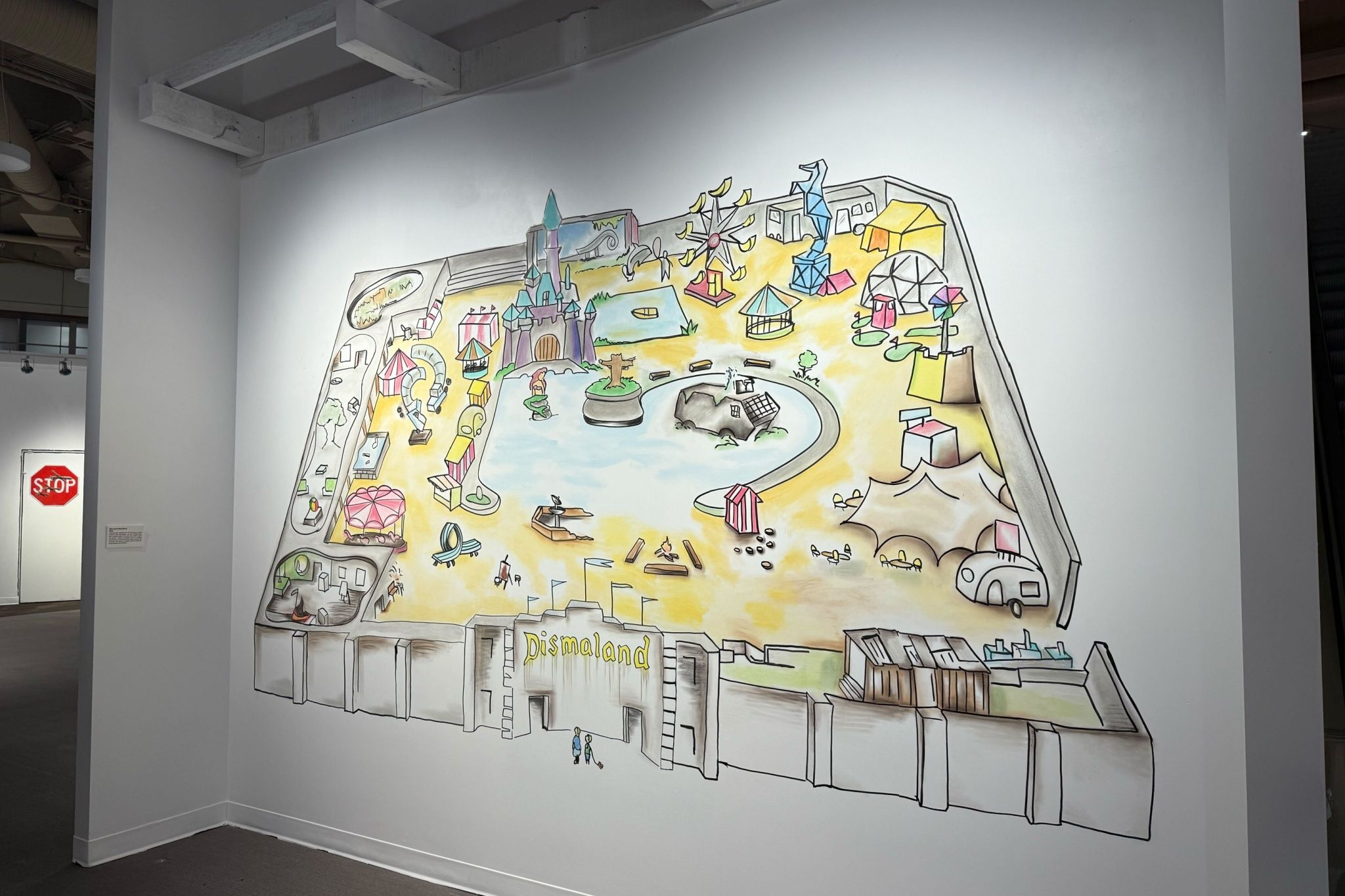Abraham Lincoln Goes to the Theatre is a matryoshka doll of a play. Larry Tremblay’s 2005 script, translated from the French by Chantal Bilodeau, follows an ambitious theatre director (Peter James Haworth) staging John Wilkes Booth’s assassination of Abraham Lincoln with a strange twist: Haworth’s director plays Abraham Lincoln as a wax figure, while two actors (Drew Moore and Vincent Leblanc-Beaudoin) perform the assassination as comedy duo Laurel and Hardy. Bilodeau’s translation fluently captures both the play’s passion and its comedy.
There are yet more layers than this conceit reveals, as actors play actors playing actors in plays within plays within plays. Andrée-Ève Archambault’s set design mirrors this meta sensibility, as the curtain before which Laurel and Hardy begin their vaudevillian act eventually opens to reveal a rehearsal space that’s seen better days, its back wall yet another curtain which reveals a tiny but glamorous proscenium theatre, several more layers of curtains making up its wings.
Directed by Sarah Kitz, the Great Canadian Theatre Company’s new production further dramatizes the construction of theatre. Laurel and Hardy put together the mini-stage’s apron in a slapstick sequence after wheeling in Abraham Lincoln on an upholstered chair far nicer than the rest of the rehearsal space’s dingy furniture. Throughout the demanding rehearsals which are the bulk of the play’s action, Lincoln (or rather his character-actor) has made himself up as a wax figure, both director and set.
After this action begins, it doesn’t let up: The play has no scene breaks, and once the three actors step onto the stage, they never leave (until, at a crucial moment, Lincoln gives the other two some necessary privacy). Martin Conboy’s lighting design frequently transforms the space: spotlights narrow the stage to the intimate bubble of a soliloquy, and in particularly theatrical sequences, the stage basks in bright colours and sudden music that ranges from patriotic marches to Madama Butterfly (sound design by Ali Berkok). The production’s primary punctuation, however, is the actors’ speech, which transports us between rehearsal sequences and segments of narration and monologue. These segments reach beyond the set’s worryingly mold-spattered walls to tell a different story, or perhaps several — historical and biographical investigations, interpretations of political and personal violence, the anxieties of illness and mortality, and a narrative of tragic love.
Haworth makes for a brilliant bully, delivering impassioned monologues and ordering around his character’s actors with a fervour that is hilariously at odds with the ambiguity of the actual directions he’s delivering. Moore and Leblanc-Beaudoin are a superb comedic duo, but don’t always stick the landing when they shift from fast-paced comedy patter to the script’s more understated, personal moments. The central issue is the rapid pace of their delivery. It may be an intentional choice for the complex actor-characters not to dwell on the significance of their words, but it still results in the sense that their delivery isn’t quite letting the script breathe.
Kitz’s production is at its best when it celebrates contradiction: vaudeville meets Puccini, speech shares the stage with absurd choreography, characters refer to each other by conflicting names, and the play jumps rapidly from moment to moment, its logic located in the clash between segments rather than their coherence. Even the question of what play the audience is watching isn’t easily answered.
For all its contradictions, Abraham Lincoln Goes to the Theatre is a coherent world whose rules become clear when they are broken. The show’s treatment of violence is highly effective: despite the fact that it hinges around a real-life murder, Lincoln’s musings on violence feel curiously abstract, and the slapstick altercations between Laurel and Hardy (with fight design by Richard Lee) seem to preclude the possibility of real danger, even when they begin to venture beyond the slapstick. Violence is so frequently play-acted that it seems impossible — until it isn’t.
The inevitable question is what this production has to say about the “true face of America,” as the GCTC’s program description promises, at a moment when the U.S. is perhaps more hated by Canadians than ever before. The script’s political assertions can feel disconnected from our current, hyperspecific geopolitical context. Individual lines do ring comedically true, such Haworth’s irreverently delivered, “Who today would want to assassinate a U.S. president?” (which generated perhaps the biggest laugh of the evening, rivalled only by Hardy removing his fake mustache to reveal an identical mustache underneath, a brilliant move by costume designer Vanessa Imeson).
Kitz’s production leans into the play’s real strength: its exploration of narrative. The characters attempt to narrativize the play’s events before, after, and even while they take place. But their failure to impose narrative logic onto complex realities only results in escalating cycles of violence. Capturing the brutal absurdity that underpins our age of widespread and hypervisible political violence, the play succeeds, like John Wilkes Booth, in kidnapping reality and transforming it into theatre.
Abraham Lincoln Goes to the Theatre runs at the Great Canadian Theatre Company until November 9. More information is available here.
Intermission reviews are independent and unrelated to Intermission’s partnered content. Learn more about Intermission’s partnership model here.


![1st Nov: Standing on the Shoulders of Kitties: The Bubbles and the Sh*trockers Story (2024), 1hr 50m [R] (6/10)](https://occ-0-533-1007.1.nflxso.net/dnm/api/v6/Qs00mKCpRvrkl3HZAN5KwEL1kpE/AAAABSeRP4ggdFAttvda_QE3Aer6OfC-htHmDSMLK3bdrJnkzU8dwbTVIwW93pELLWD7NLWhOEFpbgUsYHkZhGv47ZxkdHWCQEXBaD6Iyzt6qDaqFDG0-MyRe60GYn96JduPVu3TCIf2XVFsIs4zCiaK2Yvi2tpF8Vpro1h44LEg4-KySA.jpg?r=c04)




![1st Nov: A Knight's Tale (2001), 2hr 12m [PG-13] – Streaming Again (6.5/10)](https://occ-0-533-1007.1.nflxso.net/dnm/api/v6/Qs00mKCpRvrkl3HZAN5KwEL1kpE/AAAABZf7H5V_ILwWk3gChox71K3v0a1GgirzuCdXafKaucSSDEbhhaG_TMwBvTxaQFLBOO22aGA1lG2g_MJZPabbp0t7tIs0FssB0auh.jpg?r=10a)










